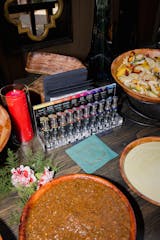When I created SpiceQuest, it wasn’t just about chili peppers. It was about giving people the power to explore heat like never before — not as an afterthought sprinkled from a jar, but as an experience. Personal. Precise. Beautiful.
But curiosity doesn’t sit still. It grows, expands, demands more.
And so it took me somewhere unexpected: a corner of the internet filled with people who shared the same obsession.
The Groups I Didn’t Belong To
I joined Facebook groups, Reddit threads, forums — not to sell anything. Just to listen.
These communities had their own rhythm, their own unspoken rules. You don’t barge in. You watch. You learn.
And what I saw pulled me deeper. Growers, proud as parents, sharing photos of peppers so vivid they looked unreal — inky purples, electric reds, caramel browns. But it wasn’t just the colors. It was the names: Kraken. Gator Jigsaw Purple. 7-Pot Peach Bubblegum. Naga Smooky Rainbow.
Names that sounded more like folklore than food.
And the conversations? They weren’t about heat. They were about discovery: "Why is this one bleeding at the stem? Have you seen this color pattern before? What's that bug on the leaf?"
I was witnessing something ancient — the passing of knowledge. Chili peppers, after all, have been shared across generations long before modern kitchens, with roots tracing back to Mexico before spreading around the world.
And I couldn’t just watch anymore.
The "Crack Pepper" Phase
I started buying them. Small, medium, and large "flat rate" boxes of rare, fresh peppers from growers I had never met from almost every corner of this great country.
At first, it was just curiosity — a desire to hold these beautiful, dangerous creations in my hands. But curiosity turned to compulsion.
I vacuum-sealed and froze them just to preserve their perfection. Then I began deseeding, destemming, dehydrating, and grinding them down, one varietal per grinder, until my kitchen looked like an apothecary of spice.
Simple grinders. No fancy branding. Just the pepper’s name, handwritten on a sticker.
But something incredible happened when I shared them.
Friends would come over, and I’d say: "You have to try this one — Big Mustard Mama. Or wait... taste Burning Bush Habanero!"
And what I loved most wasn’t just the heat. It was watching their reactions — how some peppers burned slow, building with every breath, while others hit fast and vanished, leaving only the memory of fire.
Then, something different caught my eye.
The Chocolates
One evening, amid the chaos of grinders on my table, I noticed a pattern.
Five of them were filled with so-called "chocolate" peppers.
Not chocolate flavored — the color. Deep browns and caramels, shades you’d expect from a box of fine truffles, not peppers capable of setting your mouth on fire.
Chocolate Hydra. Chocolate Scorpion. Chocolate Brain Strain. Apocalypse Chocolate. Chocolate Primotali.
I lined them up, a gradient of heat and beauty, snapped a shot, and posted a picture for my friends with the caption:
"Life is like a box of chocolates."

And just like that, a question formed:
What if I made a box of chocolates... but with fire instead of sweetness?
A collection designed not for dessert but for discovery.
Designing Fire
Once the idea took hold, it wouldn’t let go.
But ideas are easy. Execution is hard.
What would the box feel like? How would it open? Could I make it feel like a true experience—something that whispered mystery instead of just heat?
I reached out to a friend, a designer who’s been my creative muse for years. I described the idea: grinders, rare peppers, and a love story tied together by chocolate fire. And then I let her create.
A few weeks later, she returned with a design that stopped me in my tracks: A box where each grinder resembled a cylinder of fine chocolate — wrapped in cream and brown hues. A wax seal on the front. An envelope inside with an ode to spice tucked away like a secret message, waiting to be unfolded.
It was perfect. And it scared me.
Fear and Fire
Could we actually make this?
The details felt so intricate. The design so personal. And what if people thought it was actual chocolate? What if the whole thing felt like a gimmick?
But then she said something that changed my thinking:
"If it’s special, it doesn’t have to be easy. Make it by hand. Let it feel rare."
And that’s when it clicked for me.
Chili peppers have never been about simplicity. They’ve been about heat and myth and story. Ancient cultures believed peppers could ward off evil spirits — and in parts of Italy, chili-shaped charms called Cornicellos are still worn for luck, a twist on ancient Roman symbols of fertility.
The peppers themselves evolved for defense. Their heat — thanks to capsaicin — is designed to keep mammals from eating them because mammals destroy seeds. Yet here we are, not just eating them but celebrating the burn.
There’s nothing easy about any of this. And that’s the point.
The Chocolate Kit Is More Than a Gift
This kit isn’t just a product. It’s my love letter to spice.
It’s about curiosity — the way ideas start as a flicker and burn brighter the more you feed them.
It’s about craftsmanship — the quiet work of creating something rare and beautiful.
It’s about fire — the kind that lingers, just like the stories behind these extraordinary peppers.
And, if I’m honest, it’s also about fear. Because anytime you create something personal, you risk the world not understanding it.
But that’s the thing about spice.
It lingers. It stays with you.
And I hope that once the world experiences it, it will stay with them for a long time, too.
Sincerely,
Fabio Gratton
Chief Spiceologist
SpiceQuest
* We are now taking pre-orders for The Chocolate Kit and expect to start shipping the week of January 20th.

